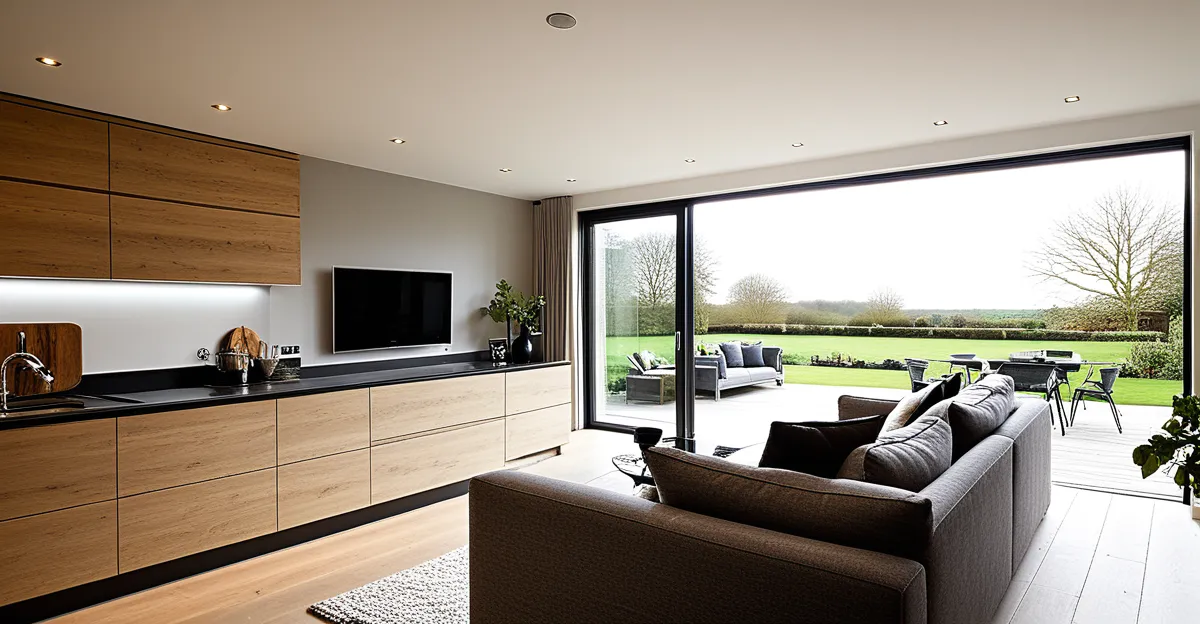Key Trends Shaping UK Home Living Spaces in 2024
The landscape of modern UK homes is evolving, with several key trends influencing residential design this year. One dominant trend is the rise of biophilic design, which brings nature indoors through abundant greenery and natural materials. This approach enhances wellbeing and connects occupants to the outdoors—even in urban settings.
Another significant movement is the shift toward flexible, multifunctional spaces. UK homeowners increasingly seek rooms that serve various purposes, such as combining workspaces with relaxation areas. This trend is crucial in cities where space constraints necessitate adaptable layouts that maximize utility without sacrificing comfort.
Also read : How Can Your Home Reflect the Latest UK Living Trends?
Moreover, the integration of smart home technology tailored for UK living is growing rapidly. Homeowners embrace automation systems managing lighting, heating, and security, often controlled via voice assistants or mobile apps. Such technology enhances convenience and energy efficiency, aligning with both lifestyle preferences and sustainability goals.
Together, these trends reflect a progressive approach to UK home trends—balancing style, practicality, and innovation. They point toward interiors that are not only visually appealing but also responsive to the evolving needs of residents in 2024.
In the same genre : How Can You Maximize Small Spaces in Your UK Home?
Innovative Layouts and Flexible Living Spaces
Flexibility is at the heart of modern UK homes in 2024. As urban living spaces shrink, the popularity of open-plan living continues to rise. Combining kitchens and living areas creates a sense of spaciousness, promotes social interaction, and maximises usable square footage efficiently.
Multifunctional rooms are another key feature shaping residential design. With the increase in remote working, dedicated home offices or work nooks integrated within living spaces have become essential. These areas often double as guest rooms or hobby spaces, demonstrating the importance of adaptable homes UK residents seek.
For many, space optimisation is necessary due to high property prices and compact city dwellings. Clever storage solutions, foldaway furniture, and movable partitions support the trend towards creating rooms that adapt seamlessly to changing needs. This adaptable approach is especially vital in smaller flats and terraced homes, where every inch counts.
Incorporating these flexible layouts addresses practical challenges while aligning with evolving lifestyle demands. Homeowners benefit from interiors that accommodate work, leisure, and socialisation in one efficient footprint, making open-plan living and multifunctional designs a defining trend in UK residential design for 2024.
Sustainable Design and Eco-Friendly Materials
Sustainable homes UK represent a growing priority in residential design for 2024. Homeowners increasingly choose eco-materials such as reclaimed timber, recycled metal, and locally sourced stone to reduce environmental impact. These materials not only lower carbon footprints but also add authentic character to interiors, combining beauty and responsibility effectively.
Energy efficiency is another cornerstone of sustainable homes UK. Modern installations like LED lighting, advanced insulation, and low-energy heating systems help maintain comfort while cutting utility costs. Incorporating solar panels or heat pumps further supports green living ambitions, aligning with the UK government’s push for environmentally conscious renovations.
Indoor greenery plays a pivotal role in this trend. Living walls and abundant houseplants improve air quality and enhance occupants’ wellbeing, reinforcing the biophilic elements seen in modern UK homes. These natural touches bridge the gap between sustainability and aesthetic appeal, creating healthier spaces.
In summary, sustainable homes UK focus on three key elements: eco-materials, energy efficiency, and integrating nature indoors. Homeowners embracing these principles enjoy spaces that are not only stylish but aligned with the urgent need for green living in the UK housing market today.
Smart Home Solutions Gaining Popularity
Smart home technology UK is rapidly transforming modern UK homes by enhancing convenience, security, and energy management. This trend reflects growing demand for connected living that adapts to daily routines effortlessly. Homeowners increasingly embrace home automation systems controlling lighting, heating, and security through intuitive interfaces like mobile apps and voice-assisted devices.
How do these systems improve everyday life? By enabling remote control and monitoring, smart home technology UK allows users to optimise energy use, improving sustainability while reducing bills. For example, intelligent heating systems learn occupancy patterns, adjusting temperatures to maximise comfort and efficiency without manual input.
Voice-assisted devices serve as central hubs, streamlining control of multiple smart features simultaneously. Integrated entertainment systems also benefit from automation, offering personalised experiences that adjust to user preferences.
Safety is a crucial aspect, with smart security systems providing real-time alerts and remote surveillance, enhancing peace of mind for UK residents.
In sum, smart home technology UK combines practicality and innovation, making it an indispensable element of residential design. Its user-friendly nature ensures accessibility across age groups, positioning it as a key player in evolving UK home trends for 2024. Adopting such technology helps homeowners create responsive, energy-efficient living environments tailored to their unique lifestyles.
Popular Interior Design Themes and Palettes
In 2024, UK interior styles reveal a rich blend of tradition and modernity. Homeowners increasingly favour warm neutrals as foundational colours, creating soothing backdrops that enhance natural light within modern UK homes. These tones pair beautifully with bold accents—think deep blues, emerald greens, or burnt oranges—to inject personality and vibrancy without overwhelming the senses.
Layered textiles are another standout feature in UK home trends. Combining varied textures, such as velvet cushions, linen throws, and wool rugs, builds depth and invites tactile comfort. This approach supports a welcoming atmosphere that complements multifunctional spaces, balancing practicality with coziness.
Vintage-modern blends dominate current residential design preferences. Pieces inspired by mid-century design, like sleek wooden furniture with tapered legs, are juxtaposed with contemporary décor elements. This fusion addresses a growing desire for personalised interiors that honour heritage while embracing emerging styles.
Statement décor items serve as centres of attention in living spaces. Oversized mirrors, sculptural lighting, and artisan ceramics provide visual interest, elevating everyday rooms without clutter. These carefully selected elements align with the UK’s trend toward curated, meaningful interiors that reflect the homeowner’s unique style.


